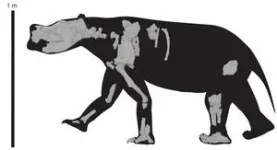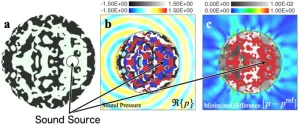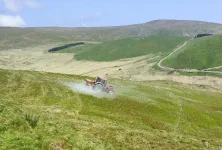(Press-News.org) One of Australia’s first long-distance walkers has been described after Flinders University palaeontologists used advanced 3D scans and other technology to take a new look at the partial remains of a 3.5 million year old marsupial from central Australia.
They have named a new genus of diprotodontid Ambulator, meaning walker or wanderer, because the locomotory adaptations of the legs and feet of this quarter-tonne animal would have made it well suited to roam long distances in search of food and water when compared to earlier relatives.
Researchers say the skeleton of Ambulator keanei, found on the Australian Wildlife Conservancy’s Kalamurina Station in northern South Australia by Flinders University researchers in 2017, belongs to a species in the family Diprotodontidae, a group of four-legged herbivores that were the largest marsupials to ever exist.
“Diprotodontids are distantly related to wombats – the same distance as kangaroos are to possums – so unfortunately there is nothing quite like them today. As a result, palaeontologists have had a hard time reconstructing their biology,” says Jacob van Zoelen, a PhD candidate at the Flinders University Palaeontology Laboratory.
The largest species, Diprotodon optatum, grew to the size of a car, weighing up to 2.7 tonnes. Diprotodontids were an integral part of Australian ecosystems until the last species became extinct about 40,000 years ago.
During the period when Ambulator keanei was alive (the Pliocene), there was an increase in grasslands and open habitat as Australia became drier. Diprotodontids likely had to travel much greater distances to obtain enough food and water to keep them going.
“We don’t often think of walking as a special skill but when you’re big any movement can be energetically costly so efficiency is key,” says Mr van Zoelen.
“Most large herbivores today such as elephants and rhinoceroses are digitigrade, meaning they walk on the tips of their toes with their heel not touching the ground.
“Diprotodontids are what we call plantigrade, meaning their heel-bone (calcaneus) contacts the ground when they walk, similar to what humans do. This stance helps distribute weight when walking but uses more energy for other activities such as running.”
Diprotodontids display extreme plantigrady in their hands as well, by modifying a bone of the wrist, the pisiform, into a secondary heel, Mr van Zoelen explains.
This ‘heeled hand’ made early reconstructions of these animals look bizarre and awkward, he says.
“Development of the wrist and ankle for weight-bearing meant that the digits became essentially functionless and likely did not make contact with the ground while walking. This may be why no finger or toe impressions are observed in the trackways of diprotodontids.
“So, diprotodontids such as Ambulator may have evolved this morphology to traverse great distances more efficiently. This morphology also allowed for greater weight to be supported, allowing diprotodontids to get very big indeed.
“Eventually, this led to the evolution of the giant and relatively well-known Diprotodon.”
Most studies on the group have focused on the skull, as associated skeletons are rare in the fossil record. As such, the newly described skeleton is of great importance and is even more special as it is the first to be found with associated soft tissue structures.
Using 3D-scanning technology, the Flinders team was able to compare the partial skeleton with other diprotodontid material from collections all over the world.
Encasing the foot of the individual was a hard concretion that formed shortly after death. By CT scanning the specimen, soft tissue impressions preserving the outline of the footpad were revealed.
Note to editors: The specimen was 3D-scanned and the files are now freely available for anyone to download and look at online. They will also be included in the new Virtual Australian Museum of Palaeontology (VAMP), to be launched by Flinders Palaeontology researchers and associates on the 1 June, 2023.
The new article, Redescription of the Pliocene marsupial Ambulator keanei comb. nov. (Diprotodontidae) from inland Australia and its locomotory adaptations (2023) by Jacob D van Zoelen, Aaron B Camens, Trevor H Worthy and Gavin J Prideaux has been published in the Journal of Royal Society Open Science DOI: 10.1098/rsos.230211
https://dx.doi.org/10.1098/rsos.230211
Acknowledgements: This research was funded by the Australian Government Research Training Program Scholarship (Excellence). Travel to collections was partially funded by the Royal Society of South Australia small grant scheme 2018, the Univerasity of California Museum of Palaeontology Doris O. and Samuel P. Welles Fund 2019, Flinders University Higher Degree Research International Conference Travel Grant 2019 and the North American Palaeontology Conference Student Travel Grant. For assistance in the field at Kalamurina Station, we thank Tess McLaren and Keith Bellchambers from the Australian Wildlife Conservancy.
END
Quarter-ton marsupial roamed long distances across Australia’s arid interior
3D scans lead to naming of a new genus of diprotodontid
2023-05-30
ELSE PRESS RELEASES FROM THIS DATE:
Source-shifting metastructures composed of only one resin for location camouflaging
2023-05-30
The field of transformation optics has flourished over the past decade, allowing scientists to design metamaterial-based structures that shape and guide the flow of light. One of the most dazzling inventions potentially unlocked by transformation optics is the invisibility cloak — a theoretical fabric that bends incoming light away from the wearer, rendering them invisible. Interestingly, such illusions are not restricted to the manipulations of light alone.
Many of the techniques used in transformation optics have been applied to sound waves, giving rise to the parallel field of transformation acoustics. In fact, researchers ...
Code-switching in intercultural communication: Japanese vs Chinese point of view
2023-05-30
When people communicate, speakers and listeners use information shared by both the parties, which is referred to as ‘context.’ It is believed that there are cultural differences in the degree of reliance on this context, with Westerners having a low-context culture, i.e., they speak more directly, and Easterners having a high-context culture, i.e., they are subtle and speak less directly.
Although Chinese are assumed to be in a high-context culture, Yamashina (2018) found that Chinese people are viewed as more direct speakers i.e., low-context cultural communicators ...
Trials will investigate if rock dust can combat climate crisis
2023-05-30
Scientists at the UK Centre for Ecology & Hydrology (UKCEH) are trialling an innovative approach to mitigating climate change and boosting crop yield in mid-Wales. Adding crushed rock dust to farmland has the potential to remove and lock up large amounts of carbon dioxide from the atmosphere.
In the first trial of Enhanced Rock Weathering on upland grasslands in the world, UKCEH scientists have applied 56 tonnes of finely ground basalt rock from quarries to three hectares of farmland in Plynlimon, Powys, this month and are repeating this at the same time next year.
The basalt rock dust particles, which are less than 2mm in size, absorb and store carbon at faster rates ...
Women with a first normal weight offspring and a small second offspring have increased risk of cardiovascular mortality
2023-05-30
A new study from the University of Bergen reveals that including offspring birthweight information from women’s subsequent births, is helpful in identifying a woman's long-term risk of dying from cardiovascular causes.
Knowledge of the association between offspring birthweight and long-term maternal cardiovascular disease (CVD) mortality is often based on first-born infants without considering women’s consecutive births.
“These possible relations are also less closely studied among women with term deliveries”, ...
ENDO 2023 press conferences to highlight emerging technology and diabetes research
2023-05-30
CHICAGO—Researchers will delve into the latest research in diabetes, obesity, reproductive health and other aspects of endocrinology during the Endocrine Society’s ENDO 2023 news conferences June 15-18.
The Society also will share its Hormones and Aging Scientific Statement publicly for the first time during a news conference on Friday, June 16. Reporters will have an opportunity to hear from members of the writing group that drafted the statement on the research landscape.
Other press conferences will feature select abstracts that are being presented at ENDO 2023, the Endocrine Society’s annual meeting. The event is being held at McCormick Place in Chicago, Ill. ...
New tool may help spot “invisible” brain damage in college athletes
2023-05-30
An artificial intelligence computer program that processes magnetic resonance imaging (MRI) can accurately identify changes in brain structure that result from repeated head injury, a new study in student athletes shows. These variations have not been captured by other traditional medical images such as computerized tomography (CT) scans. The new technology, researchers say, may help design new diagnostic tools to better understand subtle brain injuries that accumulate over time.
Experts have long known about potential risks of concussion among young athletes, particularly for those who play high-contact sports such as football, hockey, and soccer. Evidence is now mounting ...
The next generation of solar energy collectors could be rocks
2023-05-30
The next generation of sustainable energy technology might be built from some low-tech materials: rocks and the sun. Using a new approach known as concentrated solar power, heat from the sun is stored then used to dry foods or create electricity. A team reporting in ACS Omega has found that certain soapstone and granite samples from Tanzania are well suited for storing this solar heat, featuring high energy densities and stability even at high temperatures.
Energy is often stored in large batteries when not needed, but these can be expensive and require lots of resources to manufacture. A lower-tech alternative ...
Hidden in plain sight: Windshield washer fluid is an unexpected emission source
2023-05-30
Exhaust fumes probably come to mind when considering vehicle emissions, but they aren’t the only source of pollutants released by a daily commute. In a recent ACS’ Environmental Science & Technology study, researchers report that alcohols in windshield washer fluid account for a larger fraction of real-world vehicle emissions than previous estimates have suggested. Notably, the levels of these non-fuel-derived gases will likely remain unchanged, even as more drivers transition from gas-powered ...
Humans evolved to walk with an extra spring in our step
2023-05-30
A new study has shown that humans may have evolved a spring-like arch to help us walk on two feet. Researchers studying the evolution of bipedal walking have long assumed that the raised arch of the foot helps us walk by acting as a lever which propels the body forward. But a global team of scientists have now found that the recoil of the flexible arch repositions the ankle upright for more effective walking. The effects in running are greater, which suggests that the ability to run efficiently could have been a selective pressure for a flexible arch that made walking more efficient too. This discovery could even help doctors improve ...
Bile acid receptor could be innovative target in protecting the vision of premature newborns
2023-05-30
AUGUSTA, Ga. (May 30, 2023) – It sounds like bile acid in the eye would hurt, but scientists think stimulating one of its receptors can actually help protect the vision of premature newborns.
It’s called the farnesoid-X-receptor, or FXR, a bile acid receptor whose expression is significantly diminished in two key cell types affected by retinopathy of prematurity.
Medical College of Georgia scientists have early evidence that targeting that receptor could provide earlier, more impactful treatments for these babies, a process that could be expedited by the fact that the drugs they ...
LAST 30 PRESS RELEASES:
Mosquitoes’ thirst for human blood has increased as biodiversity loss worsens
The stop-smoking medication varenicline may also work for cannabis use disorder
Potential new treatment for sepsis
Study reveals how many hours of video games per week might be too many
Electrospinning for mimicking bioelectric microenvironment in tissue regeneration
Home fingertip oxygen monitors less accurate for people with darker skin tones
Six weeks in a cast no less effective than surgery for unstable ankle fractures
Precautionary approach to alcohol-free and low alcohol drinks needed to protect public health, say experts
Gas-atomized Ca–Mg alloy powders produce hydrogen simply by adding water — high-efficiency hydrogen generation at room temperature
British redcoat’s lost memoir reveals harsh realities of life as a disabled veteran
World-leading rare earth magnet recycling facility launches in UK
Corday Selden selected for the Oceanography Society Early Career Award
MIT chemists determine the structure of the fuzzy coat that surrounds Tau proteins
Same moves, different terrain: How bacteria navigate complex environments without changing their playbook
Severe weather is deadly for vulnerable older adults long after the storm ends, study finds
Expert panel highlights opportunities for improving cancer studies
Hearing aid prescriptions not associated with changes in memory and thinking
Seth Zippel selected for The Oceanography Society Early Career Award
Jeremy Horowitz selected for The Oceanography Society Early Career Award
Kennesaw State University’s Jerry Mack named Paul “Bear” Bryant Newcomer Coach of the Year
Ancient teeth are treasure troves of data on Iron Age lifestyles
Avocados may become easier to grow in India—but not if global emissions remain high
Pregnant women with IBD show heightened inflammation in vaginal mucosa
Underwater photos show seabirds, seals and fish interacting with a tidal turbine in Washington State
1 in 5 surveyed UK adults who have experienced the death of a pet report it as more distressing than experienced human deaths, with significant rates of prolonged grief disorder symptoms also being re
Polyester microfibers in soil negatively impact the development of cherry tomato plants in experiments, raising concerns over the potential effect of high levels of such contaminants
LGBTQ+ adults may be around twice as likely to be unemployed or to report workforce non-participation compared to heterosexual adults, per large representative Australian survey
Horses can smell fear: In experiments where horses smelled sweat from scared humans, they reacted to scary and sudden events with increased fear and reduced human interaction
New synaptic formation in adolescence challenges conventional views of brain development
Scientists identify target to treat devastating brain disease
[Press-News.org] Quarter-ton marsupial roamed long distances across Australia’s arid interior3D scans lead to naming of a new genus of diprotodontid








